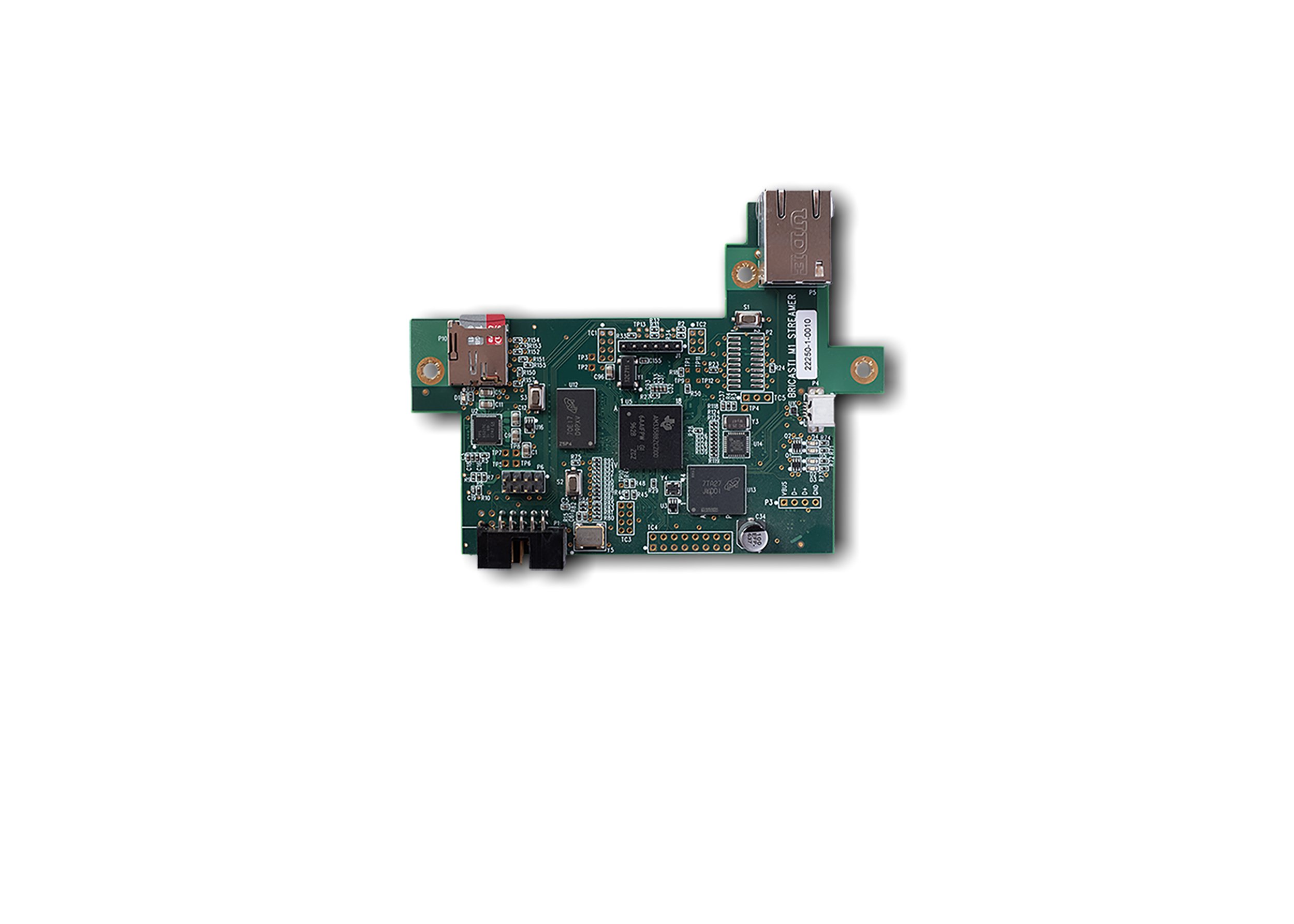

NETWORK PLAYER CARD
BRICASTI DESIGN - HISTORY - NEWS - REVIEWS - TECHNOLOGIES - PRODUCTS - CLASSIC SERIES - SOURCES - PREAMPLIFIERS - AMPLIFIERS - PLATINUM SERIES
The Bricasti Network Player Card was first introduced by Bricasti Design in 2016 and offers one of the most sonically advantages avenues for audio playback created in the last decade, with pristine data transmission over long distances without loss of signal or degradation from cable runs. This means your server can be located anywhere on the network rather than in your listening space, creating a clutter-free listening environment and ground-breaking performance.
This offers exceptional streaming capabilities that integrate seamlessly with Bricasti's DACs to deliver high-fidelity audio performance. When used with compatible audio software such as Roon, JRiver, Audirvana, and JPlay with a PC or a server connected through your network, it provides a streamlined, hassle-free setup in your listening space, bringing out the best in your digital music collection effortlessly.
The Bricasti Network Player card, along with its compatible software, offers a sophisticated and flexible solution for audiophiles who want outstanding streaming performance combined with convenience and ease of use. To find recommended music software and compatible Bricasti products for the Network Card, please visit the links below.
RECOMMENDED AUDIO APPLICATIONS
SUPPORTED NETWORK PLAYER SOURCES
Advantages of Using a Bricasti Network Card
The Bricasti Network Card delivers numerous benefits when used over Ethernet instead of directly connecting a server to a DAC:
Cleaner Signal: The network card isolates the DAC from noise and interference generated by the server, significantly improving sound quality.
Flexibility: With Ethernet, your server can be placed anywhere on the network, allowing you to keep your listening area quieter and more organized.
Simplified Setup: Ethernet enables the DAC to handle data processing directly, reducing reliance on complex cabling and external devices.
Why Ethernet Surpasses USB Connections
Conventional USB connections process audio data within the server, sending the prepared signal to the DAC over a 5-volt connection. While effective, this method has inherent drawbacks:
Jitter: USB cables often introduce timing errors (jitter) due to the length and nature of the signal path.
Electrical Coupling: USB creates a direct electrical connection between the server and audio system, potentially introducing noise or interference.
Distance Limitations: USB cables are limited in length, restricting flexibility in system layout and requiring careful placement of components.
The Ethernet Advantage
With the Bricasti Network Card, Ethernet transmits pristine, un-rendered data over long distances without signal degradation. Data is rendered only millimeters from the DAC's I2S input, offering:
Minimal Jitter: The proximity of data rendering to the DAC eliminates timing errors typically introduced by longer signal paths.
Noise-Free Performance: Ethernet avoids electrical coupling, ensuring a clean and interference-free signal.
Extended Range: Ethernet supports data transmission up to 100 meters, providing unmatched flexibility for positioning your server and DAC.
This advanced integration not only simplifies your setup but also unlocks the full potential of your system, delivering outstanding audio fidelity and convenience.
so ARE DIGITAL CABLES NOT ALL DIGITAL CABLES?
Great question! While SPDIF, USB, AES/EBU, and Ethernet cables all transmit digital data, their handling of this transmission and applications differ significantly.
Here’s an overview:
1. Digital Audio Cables (SPDIF, USB, AES/EBU)
These cables are primarily designed to transmit audio-specific digital signals from one device to another, such as from a source (e.g., CD player, streamer) to a DAC.
SPDIF (Coaxial or Optical):
Typically transmits uncompressed audio using a single-channel protocol.
Limited bandwidth, generally used for stereo audio or compressed formats like Dolby Digital.
Can suffer from signal degradation over longer cable runs.
USB (Universal Serial Bus):
Carries data and power (5V) on the same connection to enable device communication.
Requires the DAC or receiving device to handle the clocking and processing of the audio stream.
Its performance can be affected by electrical noise from the connected computer or server.
AES/EBU (Audio Engineering Society/European Broadcasting Union):
A professional-grade digital audio interface.
Uses balanced XLR connectors and is more resistant to interference than SPDIF.
Well-suited for studio applications due to its robustness and ability to handle longer cable runs compared to SPDIF.
2. Ethernet Cables
On the other hand, Ethernet cables are designed for network communication rather than direct audio transmission.
Data Packets, Not Streams:
Ethernet transmits data in packets via a network (e.g., a local area network or LAN). The receiving device reassembles these packets into the original audio signal. This asynchronous transmission gives the DAC or playback device greater control over timing (jitter).No Distance Limitation for Audio Quality:
Ethernet excels in long-distance data transmission without signal degradation or interference, provided the network infrastructure is robust.Streaming Flexibility:
It allows audio files to be accessed and streamed from servers, NAS devices, or online services, offering a decentralised approach.High-Resolution & Multichannel Capability:
Ethernet supports high-resolution and multichannel audio transmission, making it ideal for complex setups like home cinemas or studio environments.
IN CONCLUSION
The primary distinction, therefore, lies in their purpose and approach to data handling:
Digital audio cables (SPDIF, USB, AES/EBU) are point-to-point connections optimised for real-time audio streams. Their performance often depends on the quality of the cable, connectors, and hardware handling the signal.
Ethernet cables are part of a network infrastructure, transmitting data packets for playback devices to decode. They focus on reliability and consistency over distance, providing a more flexible and scalable solution for high-quality audio systems.
While they’re all digital cables, Ethernet is more versatile and capable of adaptation in modern networked audio environments, whereas SPDIF, USB, and AES/EBU are optimised for direct audio playback connections and are limited to signal integrity.







